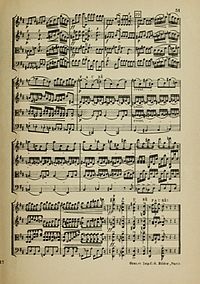|
|
| |
|
|
| |
|
|
|
|
| |
 |
| A page from the
score for a string quartet for two violins,
viola and cello. |
Composition
Musical composition, music composition or simply
composition, can refer to an original piece or work of
music, either vocal or instrumental, the structure of a
musical piece or to the process of creating or writing a
new piece of music. People who create new compositions
are called composers. Composers of primarily songs are
usually called songwriters; with songs, the person who
writes lyrics for a song is the lyricist. In many
cultures, including Western classical music, the act of
composing typically includes the creation of music
notation, such as a sheet music "score," which is then
performed by the composer or by other musicians. In
popular music and traditional music, songwriting may
involve the creation of a basic outline of the song,
called the lead sheet, which sets out the melody, lyrics
and chord progression. In classical music, orchestration
(choosing the instruments of a large music ensemble such
as an orchestra which will play the different parts of
music, such as the melody, accompaniment, countermelody,
bassline and so on) is typically done by the composer,
but in musical theatre and in pop music, songwriters may
hire an arranger to do the orchestration. In some cases,
a pop or traditional songwriter may not use written
notation at all and instead compose the song in their
mind and then play, sing or record it from memory. In
jazz and popular music, notable sound recordings by
influential performers are given the weight that written
or printed scores play in classical music. |
|
Terminology
Since the invention of sound recording, a classical
piece or popular song may exist as a recording. If music
is composed before being performed, music can be
performed from memory (the norm for instrumental
soloists in concerto performances and singers in opera
shows and art song recitals), by reading written musical
notation (the norm in large ensembles, such as
orchestras, concert bands and choirs), or through a
combination of both methods. For example, the principal
cello player in an orchestra may read most of the
accompaniment parts in a symphony, where she is playing
tutti parts, but then memorize an exposed solo, in order
to be able to watch the conductor. Compositions comprise
a huge variety of musical elements, which vary widely
from between genres and cultures. Popular music genres
after about 1960 make extensive use of electric and
electronic instruments, such as electric guitar and
electric bass. Electric and electronic instruments are
used in contemporary classical music compositions and
concerts, albeit to a lesser degree than in popular
music. Music from the Baroque music era (1600–1750), for
example, used only acoustic and mechanical instruments
such as strings, brass, woodwinds, timpani and keyboard
instruments such as harpsichord and pipe organ. A
2000s-era pop band may use electric guitar played with
electronic effects through a guitar amplifier, a digital
synthesizer keyboard and electronic drums. |
|
As a musical form
These techniques[clarification needed] draw parallels
from visual art's formal elements. Sometimes, the entire
form of a piece is through-composed, meaning that each
part is different, with no repetition of sections; other
forms include strophic, rondo, verse-chorus, and others.
Some pieces are composed around a set scale, where the
compositional technique might be considered the usage of
a particular scale. Others are composed during
performance (see improvisation), where a variety of
techniques are also sometimes used. Some are used from
particular songs which are familiar.
The scale for the notes used, including the mode and
tonic note, is important in tonal musical composition.
Similarly, music of the Middle East employs compositions
that are rigidly based on a specific mode (maqam) often
within improvisational contexts, as does Indian
classical music in both the Hindustani and the Carnatic
system. |
|
Interpretation
Even when music is notated relatively precisely, as in
Western classical music from the 1750s onwards, there
are many decisions that a performer or conductor has to
make, because notation does not specify all of the
elements of musical performance. The process of deciding
how to perform music that has been previously composed
and notated is termed "interpretation." Different
performers' or conductor's interpretations of the same
work of music can vary widely, in terms of the tempos
that are chosen and the playing or singing style or
phrasing of the melodies. Composers and songwriters who
present their own music in a concert are interpreting
their songs, just as much as those who perform the music
of others. The standard body of choices and techniques
present at a given time and a given place is referred to
as performance practice, whereas interpretation is
generally used to mean the individual choices of a
performer. |
|
|
 Kiddle: Musical composition Kiddle: Musical composition
Wikipedia: Musical composition |
|
|
|
|
|
|
|
|
|
|
|
|
|
|
|
|
Search Fun Easy English |
|
|
|
|
|
|
|
|
|
|
|
|
|
|
|
About
Contact
Copyright
Resources
Site Map |